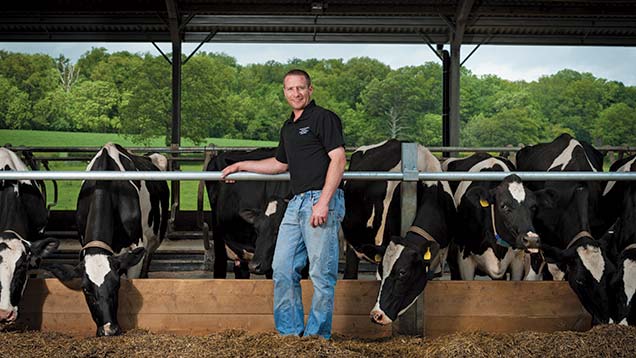Farmer Focus revisited: Paul Vicary’s dairy expansion
 Paul Vickery ©Jim Varney
Paul Vickery ©Jim Varney Losing 32ha of rented land to investors in two years might deter some dairy farmers from expanding. But former FW Farmer Focus Paul Vicary has still managed to increase his milking herd by 60 head and is in the top 10% of dairy farms in the country for margin over purchased feed, at £2,505 a head in 2014.
Although he hasn’t been able to hit his 350-cow target due to land losses, the 280 Holstein Friesians have settled in nicely to their newly built accommodation near Edenbridge, Kent, and are averaging 10,100 litres a cow a year.
See also: Read Paul Vicary’s last article
But despite the high yields he’s achieving, his aim is not to breed for litres.
“You can feed for milk and Holsteins naturally want to milk. My main concern is minimising losses through poor fertility – the number of cull cows going because I couldn’t get them in-calf.”
With this in mind he selects all AI bulls based on positive traits for fertility and milk fat percentage to suit his constituent-based contract.
The breeding policy is to use sexed semen on home-bred replacement maiden heifers to maximise genetic progress.
“They get two chances with sexed semen; after that we use Angus,” says Mr Vicary.
The rest of the herd is served three times to black and white before moving on to beef.
With a calving index of 391 days, fertility has remained steady, which Mr Vicary puts down to the proactive heat detection that he and his team carry out.
“You have to be motivated to maintain consistent heat detection year-round. We use a combination of chalking, activity meters, record-keeping and yield monitoring, but most are served after we’ve spotted them bulling.”
Using a software mating program to match the most suitable bull for each cow or heifer allows more time to be spent observing the herd.
Grass and soil management
The decision to permanently house the milkers was taken after the wet summer of 2009. The heavy Weald clay soils are not ideal for grazing in wet conditions as they poach easily, says Mr Vicary.
Producing plenty of good quality forage is therefore vital to supply the herd year-round.
For the expanding herd to cope with the land shortfall, Mr Vicary has 40ha of maize contract grown by arable farmers. He still grows some maize and wheat, and short-term Italian ryegrass makes up the majority of the leys.
“Some of these are cut once and we put maize in behind to max out the yield a hectare,” says Mr Vicary.
The rest always gives four cuts, with some leys producing up to five or six, depending on how early you cut and the weather, he adds.
The high levels of grass growth are due in part to the improvements in soil fertility, beginning with a dressing of 34% nitrogen at 180kg/ha on 1 April.
However, it was the slurry separator installation four years ago that really transformed soil nutrient management, reducing fertiliser use by 30t/year. At £250/t, that’s a significant saving of £7,500.
“We only use 60t/year of fertiliser for all our grass, winter wheat and maize [158ha],” adds Mr Vicary.
Following each silage cut, liquid slurry is spread at a rate of 125 units/ha via a dribble bar. But, last year after wet weather, Mr Vicary struggled with difficult spreading conditions and trialled an aerator.
“The late grass establishment left an open sward, which was compacted by heavy rainfall. The aerator allowed us to get more slurry on and improved nutrient uptake.”
With such good results, aeration will now be part of the routine soil management procedures.
Diversification
Building a new 20:40 swingover parlour has allowed Mr Vicary to let the old unit to small businesses for storage. This provides valuable regular income and he hopes for more commercial opportunities with other empty buildings in future.
With such volatile milk prices, a sustainable price needs to be created to avoid more farmers looking for alternative incomes, says Mr Vicary.
“At £3-4/sq ft with no overheads, sometimes I wonder what I’m still doing farming. But it’s in the blood, I’ve been doing this for 20 years now.”
Other improvements include the construction of a bungalow for the herd manager and the installation of solar panels, which since May have generated £6,000 of electricity.
Finally, there has been the arrival of baby Charlie says Mr Vicary, a new brother for Grace and Ollie.
“Hopefully the industry is in a good enough position in years to come for them to follow me into dairying if they want to.”
|
Before and after: Paul Vicary’s dairy expansion |
|
|
2013 |
2015 |
|
Milking 220 Holstein Friesians three times a day |
Expanded to 280 milkers averaging 10,100 litres a cow a year |
|
Farmed 456ha |
Lost 32ha of rented land to investors |
|
Built a new unit with a 20:40 swingover parlour |
Rents out old parlour buildings to small businesses |
|
Grew all forage crops on the farm |
Contracts out 40ha of maize to arable farmers |
|
Extreme wet weather caused issues with slurry spreading |
Aerates the soil in spring |
|
Selected AI bulls manually |
Uses mating program software to match AI bulls with females |
|
Housed year-round since 2009 |
Built a bungalow for herd manager |
|
Installed solar panels |
|
